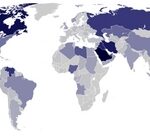The state of the American banking system before the creation of the Federal Reserve was at the mercy of the inelasticity and unpredictability of the nation’s bank credit and money supply. The unpredictability was in great part due to the fact that smaller banks routinely siphoned off their reserves to the larger banks, creating a system in which the funds of the smaller bank were theoretically guaranteed by the larger reserve banks. This system proved effective enough as long as the economy remained flexible through the normal ebb of flow of conflicting demands and supplies, with some banks lowering their reserves while others increased them. When the system fell apart due to its inherent flaw was during those periods of economic uncertainty that produced widespread public demand for currency and suddenly all the smaller banks were hitting the larger banks for their reserves.
For well over a century the U.S. had no system for facilitating efficient transfers of large deposits from the bigger banks to the smaller banks. The very fact that regions where there was a sudden extreme rush to withdraw currency had no way of quickly receiving those funds served to intensify the sense of growing panic that tended to create a domino effect: Banks that were unable to rapidly receive reserves from the central bank would begin taking actions that not only added to the general feeling of panic, but also created more economic stability. For instance, banks would demand urgent repayment of outstanding debts, refuse new loan applications and even begin selling securities in an effort to raise immediate supplies of currency. The consequences of these actions by the bank included sharp drops in the prices of those securities and making borrowing for the bank more difficult, as well as created uncertain fluctuations in interest rates.
While periods of financial panic that led to these conditions were irregular, the effects could be devastating. Banks went out of business, businesses went bankrupt, and bankruptcies created a crisis of confidence in the banking system. The Panic of 1907 was a particularly intense episode which depositors moved to liquidate savings from the two of the largest banks in the country. Unable to tap into their reserves to cover the demand, these banks eventually were forced to close, contributing to a panic across the country that other banks would follow. This panic finally convinced the nation that it had no choice but to restructure its current economic system in a way that was amenable to both regional and national needs.
The compromise involved the establishment of 12 Federal Reserve Banks that would would not be federal agencies, but remain private institutions to be owned by the member banks. The Federal Reserve Board would be charged with oversight of the banking system and establishing monetary policy. Under this arrangement, therefore, the Federal Reserve is not a part of any of the three branches of the US government, but is rather a independent regulatory agency subject to oversight by Congress.
Since the primal purpose in the creation of the Federal Reserve was to introduce an elastic that could increase or decrease as required by economic conditions, the Fed system necessitates that member banks retain a certain percentage of their assets on deposit with the Reserve Banks in the form of Federal Funds. This system also involves the issuance of Federal Reserve notes. The design of the Federal System was pointed toward the prevention of the kinds of bank panics that marked the late 1800s and early 1900s by giving its member banks a far more efficient and speedy access to liquid assets through the introduction of the discount window, which allows those banks to borrow at a discount rate. Further contibuting to the sense of economic confidence when the Federal Reserve was created as the fact that all those Reserve deposits and bank notes were no longer merely just paper since they were backed up by gold.



